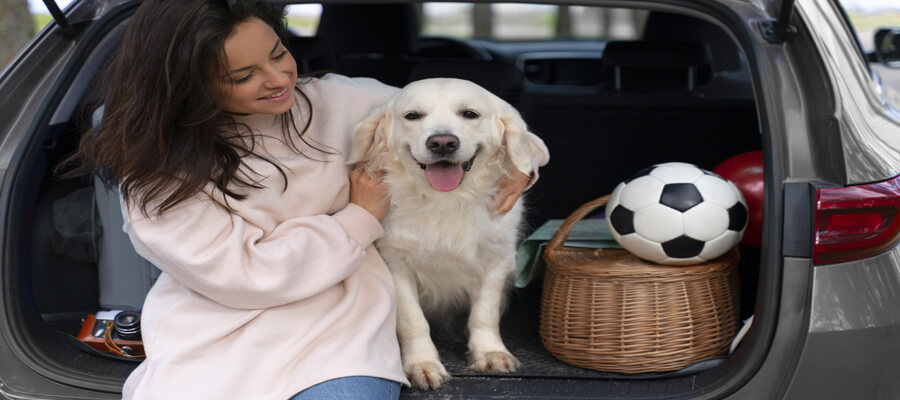
Dog Safety in the Car Best Practices for Travel
Essential Tips for Keeping Your Dog Safe in the Car
Introduction
Traveling with your dog can be one of the most enjoyable experiences, allowing you to bond and explore together. However, ensuring your furry friend’s safety in the car is paramount. Just like humans, dogs can face risks during car rides, from sudden stops to distractions. In this guide, we’ll outline essential best practices for dog safety in the car, helping you prepare for safe travels with your beloved pet.
1. Use a Secure Restraint System
Why It’s Important: Securing your dog in the car is crucial for their safety and the safety of other passengers.
- Dog Seat Belts: Invest in a quality dog seat belt that attaches to your car’s seatbelt system. This allows your dog to sit or lie down while remaining secured.
- Dog Crates and Carriers: For added safety, consider using a sturdy crate or carrier. Ensure it is well-ventilated and large enough for your dog to stand, turn, and lie down comfortably.
2. Never Allow Your Dog to Ride in the Front Seat
Essentials for Your Newly Adopted Pet
Welcoming a shelter pet into your life is a beautiful journey. Here are some handpicked items to help your new friend feel safe, loved, and right at home:
Why It’s Important: Airbags and sudden stops can pose serious dangers to dogs in the front seat.
- Keep Dogs in the Back: Always place your dog in the back seat, as this area is safer in the event of an accident.
- Use a Barrier: If your dog is overly excited or tends to jump into the front seat, consider using a pet barrier to keep them safely in the back.
3. Practice Safe Loading and Unloading
Why It’s Important: Proper loading and unloading can prevent accidents and injuries.
- Leash Up Before Opening the Door: Always put your dog on a leash before opening the car door to prevent them from bolting into traffic.
- Allow Time to Adjust: Give your dog time to acclimate to the car environment before taking off, ensuring they feel secure and comfortable.
4. Limit Distractions While Driving
Why It’s Important: A distracted driver can lead to dangerous situations on the road.
- Create a Calm Environment: Use calming music or toys to help soothe your dog and minimize distractions during the drive.
- Don’t Allow Dogs to Roam: Prevent your dog from moving around the car while driving, as this can divert your attention from the road.
5. Take Breaks During Long Trips
Why It’s Important: Just like humans, dogs need breaks during long journeys to stretch, relieve themselves, and hydrate.
- Plan Regular Stops: Schedule breaks every 2-3 hours for your dog to stretch and relieve themselves. This helps prevent anxiety and discomfort.
- Provide Water: Always have fresh water available for your dog during breaks to keep them hydrated.
6. Never Leave Your Dog Alone in the Car
Why It’s Important: Leaving a dog alone in a car, even for a short period, can lead to heatstroke or other dangers.
- Heatstroke Risks: Cars can heat up quickly, even in mild weather, putting your dog at risk. Always take your dog with you when you leave the vehicle.
- Avoid Dangerous Situations: If you must run errands, consider leaving your dog at home or taking them with you when possible.
7. Ensure Your Dog Is Comfortable
Why It’s Important: A comfortable dog is a relaxed dog, which contributes to a safer travel experience.
- Create a Cozy Space: Provide a familiar blanket or bed in the car to make your dog feel secure and comfortable.
- Use Cooling or Heating Accessories: Depending on the weather, use cooling mats or blankets to help regulate your dog’s temperature during the ride.
8. Prepare for Emergencies
Why It’s Important: Being prepared for emergencies can save lives and reduce stress during unexpected situations.
- Pack an Emergency Kit: Include items like a first-aid kit, extra leash, water, and any necessary medications in your travel bag.
- Know Local Vet Locations: Research local veterinarians or emergency animal hospitals along your travel route in case of emergencies.
9. Keep Your Dog’s ID Updated
Why It’s Important: If your dog gets lost during travel, having updated identification is crucial for a safe return.
- Use a Reliable ID Tag: Ensure your dog’s collar has an ID tag with your contact information.
- Microchipping: Consider microchipping your dog for an added layer of security. This can be especially helpful if they get lost while traveling.
10. Consider Travel-Friendly Products
Why It’s Important: Investing in travel-specific products can enhance your dog’s comfort and safety.
- Car Seat Covers: Use a protective cover for your seats to prevent dirt and hair while also providing a non-slip surface for your dog.
- Portable Water Bowls: Pack collapsible water bowls for easy hydration during breaks.
Conclusion
Ensuring your dog’s safety during car travel is essential for enjoyable and stress-free journeys. By implementing these best practices—such as using secure restraints, limiting distractions, and preparing for emergencies—you can create a safe environment for your furry companion. Traveling with your dog should be an adventure filled with fun and bonding moments, and with the right precautions in place, you can focus on the joy of exploring the world together.
Affiliate Products
We may earn a small commission when you shop through our links — it helps us keep sharing love and care for every dog out there, at no extra cost to you.
Up to 75% Discount

Dog Collar with Health Monitoring
BUY NOW »
Up to 55% Discount

Luxury Faux Furhuge Napping Bed
BUY NOW »

